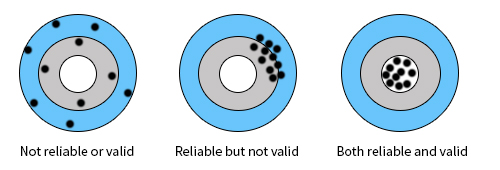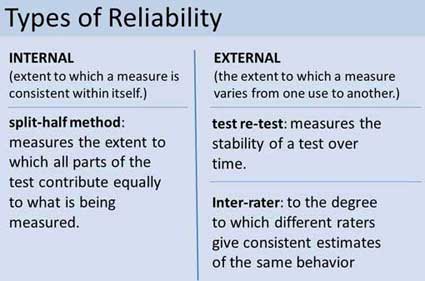Science -
Reliability & Validity
Scientific research produces results, which the scientists
analyse and report to others (usually in science
journals). These results are assessed in terms of how
reliable they are AND how valid they are. The goal is to
have findings that are BOTH.

Reliability
In science, reliability has to do
with replication. The more something is replicated in
research, the more reliable it is. Another way of putting
it is, reliability results when the same (or highly compatible)
results are achieved by same study repeated either over time, or
by different researchers, or both.
Types of Reliability:
There are several ways to determine how reliable research findings are.
They focus on the means for obtaining data (e.g., how things are
measured). So most discussions of reliability are directed at
tests that purportedly measure something (in the case of climate, this
would involve things like the reliability of the thermometers used to
measure temperature). Here are the types of reliability:

Validity
Loosely speaking, this refers to
truth (i.e., how true are the findings of the research). There
are several different types of validity.
Content/Construct Validity:
What this looks at is does the research actually study what it
says it studied (e.g., Does an IQ test really measure
intelligence)? Were the constructs (these are
theoretical concepts) and the contents (design of the study)
appropriate to the study? In other words, doing an
experiment about subatomic particles by weighing baseballs is
NOT valid.
Internal Validity:
Internal
validity occurs when it can be concluded that there is a causal
relationship between the variables being studied. A danger is
that changes might be caused by other factors. In other
words, internal validity means that we have looked at and
controlled enough of the variable, both causes and effects, to
say that A caused B. When internal validity is strong,
successful replication of the study is very likely (in other
words, it increases the reliability of the findings).
It is important to note that
experimental studies examine causal relationships, but
correlational studies do not--they just look at how two, or more
things may change together. When multi-variant (i.e.,
multicorrelational) studies occur, the correlations that arise
have a higher probability of revealing possible causality.
External Validity:
This
occurs when the finding in the study can be generalized to the
world at large. In other words, the findings aren't
limited to the laboratory.
Predictive
Validity:
Some might consider this the
ultimate goal of science, predicting what can and will happen.
Science seeks to know what causes will lead to what effects in
what circumstances. As mathematic models (often employing
probability and a new notion called "fuzzy logic") have become
more complex and sophisticated, science looks toward the
interaction of multiple causes leading to multiple effects.
A prime example of this would be weather prediction (we're
talking about local daily weather, not climate, but it can
extend into that area as well).
Scientist consider their
research and the theories they use valid when it leads to prediction
(e.g., predicting what will happen if dynamite is ignited. More
importantly, prediction can lead to control. If we can predict an
outcome from certain causes, we can possibly create the outcome when we
want and need it to happen, OR we may be able to prevent that outcomes
by eliminating the causes.
NOTE: One reasons
climatologists see climate change research (e.g., the global warming) to
be valid is the fact that it was predicted several decades ago.
And the fact that it was predicted well before any possible financial
gain also addresses the issue of motive that has led some to assert the
only reason scientists support global warming is in hopes of getting
rich off it.